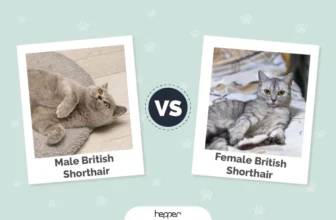Bringing a new dog into the household can be an exciting but nerve-wracking experience, especially if you already have a beloved American Shorthair cat. Introducing the two pets properly is crucial for creating a harmonious environment and preventing any potential harm or conflicts. However, it can be challenging to know where to start and how to approach the introduction to ensure both animals feel comfortable and safe. Don’t fret – we’ve got you covered! In this article, we’ll guide you through the step-by-step process of introducing American Shorthair cats to new dogs, ensuring a smooth transition and a happy home for all.
Preparing for the Introduction

Before introducing your American Shorthair to a new dog, it’s crucial to take some preparation steps to ensure a smooth interaction between the two pets. Creating a positive experience for both the cat and dog is essential for a harmonious household dynamic. In this section, we will discuss some important steps to take before introducing your American Shorthair to a new dog. These steps include confirming the new dog’s friendliness with cats, speaking with a veterinarian, setting up safe spaces, and separating food and resources to offer each animal their individuality. Taking these actions will help facilitate positive interactions between your American Shorthair and the new dog, making the introduction period less stressful for both pets. If you haven’t already done so, we recommend reading our article on how to teach cats to get along with each other, and how to help an American Shorthair overcome fear of animals to assist you further.
1. Confirm the new dog is friendly with cats
Before introducing your American Shorthair to a new dog, it is important to make sure that the new dog is friendly with cats. This step is crucial for preventing any kind of conflict or aggression.
Here are some ways to confirm if the new dog is friendly with cats:
| Methods | Pros | Cons |
|---|---|---|
| 1. Ask the previous owner or organization | – Direct information from someone who knows the dog – Possibly already socialized with cats |
– Previous owner may not disclose any potential issues – May not accurately reflect the dog’s current behavior |
| 2. Observe the dog’s behavior around cats | – Ability to see how the dog reacts to cats in real-time – Can identify potential issues before introduction |
– Must have access to a cat to conduct observation – May not be able to judge behavior in controlled environment |
| 3. Professional evaluation by a trainer or behaviorist | – Professional insight and evaluation of the dog’s behavior – May provide helpful training tips |
– Can be expensive – May not be available or necessary for every situation |
It is important to note that American Shorthair cats should also be properly socialized with other animals during their early development. For further information on this topic, refer to our article on early socialization for American Shorthair kittens.
If you recognize aggression in your American Shorthair, check out our article on coping with aggression in American Shorthair cats. Additionally, creating a safe space for your American Shorthair during playtime is crucial. For more information on how to do this, refer to our article on safe space for American Shorthair playtime.
2. Speak with a veterinarian
Before introducing your American Shorthair to a new dog, it’s important to speak with a veterinarian. They will be able to provide you with valuable insights and advice on how to make the introduction go smoothly. Here are some reasons why speaking with a veterinarian is crucial:
- Assess the health of your pets: Your vet can assess the health of your American Shorthair and the new dog that you’re introducing. They can advise you on whether they are physically fit enough for the introduction.
- Recommend behaviorists: If either of your pets have shown signs of aggression or anxiety, your vet may recommend seeing a behaviorist. A behaviorist can help in determining the root cause of the behavior and provide guidance on how to address it.
- Advice on medication: In some cases, your veterinarian may recommend medication to help your pets adjust during the introduction process. They can prescribe appropriate medication and dosage and can also monitor the success of medication in your pets.
- Guide timing: If either your Shorthair or the new dog has recently gone through surgery, or is recovering from an injury or illness, it may not be the right time to introduce them. Your vet can help you determine the best time to make their introduction.
- Provide helpful tips: Your veterinarian can provide helpful tips and advice to make the introduction of your Shorthair and new dog go smoothly. They may also be able to refer you to other resources, such as books and websites, that offer useful information.
Speaking with a veterinarian is an important step to take before introducing your American Shorthair to a new dog as it can help ensure a safe and successful introduction. Your vet can provide you with the resources and advice you need to make the introduction process as easy and stress-free as possible.
3. Set up safe spaces
Pets, just like humans, need a place where they can retreat from the outside world and relax. During the introduction process between an American Shorthair and a new dog, it’s important to provide each with their own safe space. This will allow both pets to feel more in control and reduce the chances of any confrontations.
Here are a few tips to help you set up safe spaces for your pets:
| Tip | Description |
|---|---|
| Use baby gates | Block off certain areas of your home using baby gates. This will create a physical barrier and give each pet their own space without being completely isolated. |
| Provide separate rooms | If you have the space, consider giving each pet their own room. This will ensure they have their own safe haven and can retreat there whenever they feel threatened or overwhelmed. |
| Invest in crates | Crating can help provide a safe space for your pets. Make sure the crates are large enough for the pets to move comfortably and provide plenty of bedding and toys. |
| Provide hiding spots | Cats love to hide, so make sure to provide plenty of hiding spots for them. This could be a covered bed or a cat tree with a cubbyhole. |
Remember, providing a safe space for your pets is an essential step in introducing them to each other. It will help them feel more secure, and it’s an easy way to reduce the risk of any conflict during the introduction process.
4. Separate food and resources
When introducing a new dog to your American Shorthair, it’s important to separate their food and resources to ensure a smooth transition. This means giving each pet their own bowls, beds, toys, and litter boxes.
Separate feeding areas: Cats and dogs have different dietary needs and feeding schedules. It’s important to feed them separately in different areas. Place the cat’s food and water bowls in a high or hard to reach location, as cats like to eat in private and feel safe while eating. Dogs should also be trained not to eat the cat’s food.
Separate beds: Your cat needs a designated place to sleep where the dog can’t bother them. It’s important to give your cat a high perch or a designated bed in a safe, quiet room. This will give your cat a sense of control and security. Your dog should also have their own bed in a separate room.
Separate toys: Cats and dogs have different play styles and preferences. It’s important to provide each pet with toys that are appropriate for their size and species. For instance, dogs might enjoy playing fetch or tug-of-war, while cats prefer toys that mimic prey.
Separate litter boxes: Cats are territorial animals, and they don’t like to share their space. It’s important to give your cat a separate litter box in a quiet, private location. This will also prevent the dog from getting into the litter box and making a mess.
By giving each pet their own space, you’re reducing the potential for competition and conflict between them. Remember that your cat may feel threatened or stressed by the presence of a new dog, so it’s important to make sure they feel secure in their own environment.
The Introduction

As the moment for your American Shorthair to meet their new dog companion approaches, it is important to approach the introduction with caution and care. This can be a stressful time for both pets, and it is crucial that their first interaction is positive in order to set the tone for their future relationship. In this stage of introducing your American Shorthair to a new dog, we will outline some important steps to take to ensure a successful introduction. Let’s dive in!
1. Use a barrier
When introducing your American Shorthair to a new dog, using a barrier during the initial meeting is crucial. A barrier can be anything that separates your cat and dog physically. This can be a baby gate, a pet crate, or any other sturdy divider.
The benefits of using a barrier include:
| Preventing Direct Contact: A barrier ensures that your American Shorthair and the new dog cannot directly interact, preventing any potential harm. This can help to decrease anxiety and stress for both pets. |
| Gradual Introduction: Using a barrier allows your pets to become familiar with each other’s presence in a gradual, controlled manner. This can help to prevent any sudden reactions or aggression. |
| Observation: A barrier also allows you to observe your pets’ behavior and body language while they are in each other’s presence. This can help you assess whether they are ready for closer interaction, or if you need to take things slower. |
When setting up the barrier, ensure that both pets have enough space to move around and that the barrier is secured and cannot fall over. It is also important to supervise the initial interactions to ensure that the barrier remains intact and that neither pet becomes aggressive or fearful.
2. Allow supervised interactions
When introducing your American Shorthair to a new dog, it’s important to start the interactions slowly and under supervision. You should never leave them alone together until you are confident they can coexist peacefully. Here are some tips to ensure safe and supervised interactions between your pets:
1. Use a leash: When introducing your pets, both the cat and dog should be on a leash controlled by their respective owners.
2. Use positive reinforcement: Reward good behavior from both animals with treats, praise, and pets. This can help create a positive association between the two pets.
3. Monitor interactions: Keep a close eye on both pets’ behavior during interactions. If one pet becomes aggressive or stressed, immediately separate them and try again later.
4. Space out interactions: Don’t try to force too much interaction in the beginning. Instead, gradually increase the length of interaction sessions as the pets become more comfortable around each other.
By allowing supervised interactions, you can ensure that both your American Shorthair and new dog are comfortable and safe with each other. Remember, it’s important to take things slow and not force anything. With patience and diligence, your pets can coexist peacefully.
3. Watch body language
Observing the body language of both the American Shorthair and the new dog is crucial when introducing them to each other. Their body language will clue you in on how they are feeling and whether they are comfortable or not. Here are some things to look out for:
| Body Language | What it Means |
|---|---|
| Tense body, hairs raised, or arched back | The cat or dog may be feeling defensive or scared |
| Tail wagging | The dog is excited, but it does not necessarily mean he or she wants to play with the cat |
| Staring or growling | Either the cat or the dog is feeling threatened or aggressive |
| Ears back or pinned to the head | The cat or dog is feeling either fearful, anxious, or angry. It’s best to separate them and start the introduction process over later. |
It’s essential to note that not all body language is negative. Some cats and dogs may display positive body language such as rubbing up against each other, wagging tails while near each other, or even laying down close to each other. As the owner, it’s your responsibility to keep an eye on their body language to ensure that the introduction goes smoothly without any aggression. If you notice any negative body language or signs of discomfort, it is best to separate them and try again later.
4. Keep initial meetings short
Bringing a new dog into the home can be an exciting but stressful time as you introduce them to your American Shorthair. When it comes to the actual introduction, it’s important to keep the initial meetings between the two pets short.
Why keep the initial meetings short?
Initial meetings can be overwhelming, especially for cats who are generally more cautious and territorial. By keeping the introductions short, you can help minimize stress and prevent any negative interactions between the two pets.
How short should the meetings be?
Initial meetings should only last a few minutes at a time. This allows your pets to get a sense of each other’s presence, but not too much time for anything negative to occur.
What should you look out for during these meetings?
During these initial meetings, watch closely for any signs of discomfort or aggression from either pet. Some signs to watch out for include raised fur, hissing, growling, or any sudden movements.
Here’s a helpful table to summarize the tips for keeping initial meetings short:
| Tip | Description |
|---|---|
| Why keep meetings short? | Minimize stress and prevent negative interactions |
| How short should meetings be? | A few minutes at a time |
| What to look out for? | Signs of discomfort or aggression from either pet |
Remember, taking things slow and keeping interactions short can help ensure a successful introduction between your American Shorthair and new dog.
After the Introduction
Now that the first meeting between your American Shorthair and new dog has taken place, it’s important to take some extra precautions to ensure a smooth transition. Even if the initial interaction went well, the animals are still getting used to each other and their behaviors might change. In this section, we’ll provide you with some helpful tips on how to proceed after the introduction to ensure a peaceful cohabitation between your furry friends. Let’s dive in.
1. Monitor interactions
Once your American Shorthair and new dog have interacted, it’s important to monitor their behavior and body language. This will help you identify any potential issues early on and prevent any accidents or injuries.
Here are some key behaviors to watch for:
| Behavior | What it Means |
|---|---|
| Stalking or chasing | This behavior can indicate that the new dog is still trying to assert dominance over your American Shorthair. It’s important to discourage this behavior and intervene if necessary. |
| Growling or hissing | This behavior can indicate that one or both animals are feeling threatened or defensive. It’s important to separate them if necessary and give them some space. |
| Tail wagging or purring | This behavior can indicate that the animals are feeling relaxed and happy. It’s a good sign that they are starting to get along. |
| Eye contact | This behavior can indicate that the animals are feeling curious or interested in each other. However, prolonged eye contact can also be a sign of aggression, so it’s important to watch for other behaviors as well. |
If you notice any concerning behaviors, it’s important to take action immediately. This may mean separating the animals and giving them some space, or it may mean working with a professional trainer or behaviorist to address the issue.
Remember, every animal is different, and it may take some time for your American Shorthair and new dog to adjust to each other. Be patient and continue to monitor their interactions closely. With time and proper training, your furry friends can learn to coexist happily together.
2. Continue to supervise
Once the initial introduction has gone well and both animals seem to be getting along, it’s important to continue supervising their interactions. This means keeping an eye on their body language and behavior to make sure that they are both comfortable and safe.
To ensure that you are able to keep a close eye on your pets, you can create a schedule for when they will interact with each other and when they will be separated. This may involve keeping your pets in separate rooms when you are not home or supervising their interactions from a distance when you are.
Table: Tips for Continuing to Supervise
| Tips | Explanation |
|---|---|
| Use baby gates or a room divider | These can be used to keep your pets separated when you are not able to supervise them closely. |
| Keep on a leash | You can keep your dog on a leash when they are interacting with your cat to prevent any sudden movements or aggressive behavior. |
| Stay in the room | If you want to let your pets interact without any barriers, make sure to stay in the same room as them so you can intervene if needed. |
| Interrupt any unwanted behavior | If you see your dog or cat displaying any aggressive or unwanted behavior, interrupt them quickly and calmly. |
Remember, introducing a new dog to your American Shorthair may take time and patience. By continuing to supervise their interactions and being proactive about their safety and well-being, you can help ensure that they develop a positive relationship.
3. Take things slow
It’s crucial to take things slow when introducing your American Shorthair cat to a new dog. This can help prevent any aggressive encounters and ensure they have a positive relationship. Here are some tips to keep in mind:
| Tip | Description |
| 1. | Allow your pets to get used to each other’s scent. This can be done by swapping the bedding or toys of each pet. |
| 2. | Start with short and supervised interactions. Avoid leaving them alone together until you’re confident they’re comfortable with each other. |
| 3. | Gradually increase the duration of their interactions. If there are signs of discomfort or aggression, return to shorter interactions until they become more comfortable with each other. |
| 4. | Respect their boundaries and give them plenty of space. Don’t force them to be close to each other or interact if they don’t want to. |
Remember that introducing a new dog to your American Shorthair cat may take time, but it’s worth it for their happiness and well-being. Keep an eye on their behavior and continue to supervise their interactions until you’re confident they can get along without supervision. Following these tips can help ensure a successful introduction, and a long-lasting friendship between your pets.
4. Don’t force anything
When introducing your American Shorthair to a new dog, it’s essential not to force anything. Forcing the process can cause stress and anxiety for both pets, and it can also result in potential physical harm. Instead, take things slow and allow the pets to adjust to each other’s presence at their own pace. Here are some tips for not forcing anything during the introduction:
- Observe: Observe both pets’ body language and behavior during and after the introduction. If there are any signs of aggression or discomfort, immediately separate them and try again later.
- Avoid Punishment: If there is a bit of a scuffle, avoid punishing either pet. Instead, calmly separate them and try again later.
- Be Patient: Patience is key when introducing pets to each other. It may take time before they feel completely comfortable around each other. Just be patient and give them the space they need.
- Offer Positive Reinforcement: Reward the pets with praise and treats when they exhibit positive behavior around each other. This will encourage them to continue this behavior.
Remember, every pet is different, and the process of introducing them to each other will vary depending on their personalities and behavior. Don’t force anything, and take things slow to ensure a successful and harmonious relationship between your American Shorthair and new dog.
Conclusion
In conclusion, introducing a new dog to your American Shorthair requires careful planning and supervision. It’s important to confirm that the new dog is friendly with cats and to speak with a veterinarian beforehand. Additionally, setting up safe spaces and separating food and resources can help ease the transition.
During the introduction, using a barrier and allowing supervised interactions are crucial. It’s also important to watch the body language of both pets and to keep initial meetings short. After the introduction, monitoring the interactions and continuing to supervise is necessary. Taking things slow and not forcing anything can help ensure a successful introduction.
Remember that every pet is unique, and some may take longer than others to adjust. Patience and positive reinforcement are key. With time and proper introductions, your American Shorthair and new dog can live happily together. Don’t hesitate to consult with a professional if needed. Good luck on your journey!
Frequently Asked Questions
1. Can all American Shorthairs get along with dogs?
Introducing cats and dogs can be a delicate process, regardless of breed. However, many American Shorthairs have been successfully introduced to dogs with the right preparation.
2. Do American Shorthairs tend to get along better with certain breeds of dogs?
There is no set rule for which breeds American Shorthairs will get along with best. Every cat and dog is unique and may have different tendencies when it comes to interactions.
3. How long should the introduction process take?
The introduction process may take anywhere from a few weeks to several months, depending on how the cat and dog are interacting. It’s important to be patient and take things slow to ensure a successful introduction.
4. Should I let the cat and dog have access to the same food and water bowls?
No, food and resources should be kept separate to avoid any conflicts. This includes separate bowls, beds, litter boxes, and toys for both the cat and dog.
5. Do American Shorthairs need more time to adjust to a new dog than other breeds?
There is no set amount of time that any breed requires to adjust to a new dog. Each cat will need its own amount of time to feel comfortable and adjust to the new situation.
6. Can an American Shorthair ever become friends with a new dog?
Yes, it is possible for American Shorthairs and dogs to become friends. With patience, supervision, and proper preparation, cats and dogs can learn to coexist peacefully.
7. Is it better to keep the American Shorthair separate from the new dog during the introduction process?
Yes, it’s generally a good idea to keep the cat and dog separate during the introduction process. This will allow each animal to adjust to the scent and presence of the other without feeling threatened.
8. How can I tell if the cat and dog are ready for unsupervised interactions?
Once the cat and dog have become accustomed to each other’s presence and behavior, and no aggression or fear is shown during supervised interactions, it may be safe to allow unsupervised interactions. However, it’s important to continue monitoring their behavior and interactions.
9. If the cat and dog don’t get along, what should I do?
If the cat and dog consistently display aggression towards each other, it may be necessary to keep them separated permanently. It’s important to prioritize the safety and well-being of both animals.
10. Should I punish either animal if they display aggression during the introduction process?
No, punishment typically will not help the situation and can actually make things worse. Instead, try to redirect their attention with toys or treats and give the animals some space to calm down before trying to reintroduce them.







